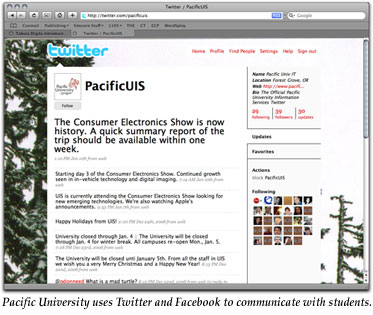University Links Twitter, Facebook with Notification System
- By Linda L. Briggs
- 01/23/09
In a move that plenty of other institutions are sure to follow, Oregon's Pacific University has integrated its emergency notification system with the popular social networking sites Facebook and Twitter. The move allows the 3,100-student university to send emergency messages to students via e-mail, RSS feed, or text message to mobile phones, Blackberries, wireless PDAs, pagers, and smart or satellite phones--and now Twitter or Facebook.
The university subscribes to an emergency notification system from Omnilert's e2Campus that allows administrators to send a single message to a designated list of recipients on a variety of devices and in various formats. In November, e2Campus added Twitter and Facebook as options--and Pacific University was the first institution to jump on board.
Since Pacific has accounts already with both Twitter and Facebook, like many other colleges and universities, the new setup with e2Campus allows Pacific staff to deliver an e2Campus alert to any student with a Twitter or Facebook account that "follows" (on Twitter) or is "friends with" (on Facebook) Pacific. Without e2Campus, the university would have to log into its account on each social networking site, craft a message, and deliver it.
According to Lee M. Colaw, vice president of information services at Pacific University, letting e2Campus contact students in emergencies through Facebook made sense. In fact, students had already requested it. When he conducted follow-up assessments on how the e2Campus system was working, Colaw said, students had suggested that the best way to reach them was via Facebook. Students said that they were already re-typing and sending out university messages via Facebook themselves. "We thought it would be more professional," Colaw said, "if the message came straight from the university instead."
Sending a message to the two social networking sites is as simple as selecting those choices in the e2Campus interface to specify additional ways that students are to receive a message. When Colaw sent a test message in November, he received a surprising response that told him the new choices were a hit. A recent alumnus responded that he had received the test alert via Twitter and highly approved. "We sent the test message," Colaw said, "and to my shock, in less than a few hours, an alum responded and said, 'That's pretty awesome!'."
Receiving alerts via e2Campus is optional for Pacific University students; Colaw said between 25 and 30 percent of campus constituents are opted in at any one time. In an emergency, the university also sends e-mail through its own e-mail system to students as well, to reach those who haven't opted in. Students who choose to receive message via e2Campus can also indicate others, such as family members, who are to receive the alerts.
Colaw said adding Twitter and Facebook is bound to increase the number of students the university reaches quickly in an emergency. In fact, because of the exponential reach of such sites--a message to the university Facebook account can immediately be seen by any "friends" following the university--an emergency message from Pacific on Facebook will reach many, many people. And that's not a bad thing, Colaw pointed out. The university has sent a single e2Campus alert in the year since it has had the system in place, and in a true emergency, he said, the more people who know about it, the better.
For Pacific, a small private liberal arts and health professions university whose main campus is located in Forest Grove, Oregon, with a health professions campus in neighboring Hillsboro and two remote campuses in Portland and Eugene, a handy feature of e2Campus is the ability to send e-mail alerts by region. If a weather emergency impacts only the Portland-area campus, an alert can be sent to those students only.
Another benefit, Colaw said: The e2Campus message is sent from a single source. Rather than having to craft an e-mail message, a text message, and an RSS feed message, along with messages in Facebook and Twitter, by using e2Campus, a university administrator can log in to the e2Campus Web site and send a single message--called a Boxer Alert after the university's mascot--to various devices and media.
"This is just one more means of reaching students," Colaw said. "We find we have to have a wide range of communications. We're always looking... We need to communicate with students through whatever means they choose to use."
About the Author
Linda Briggs is a freelance writer based in San Diego, Calif. She can be reached at [email protected].